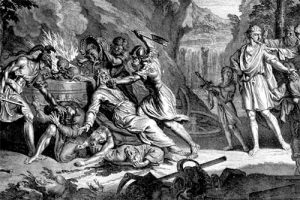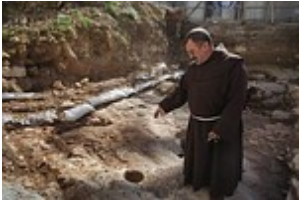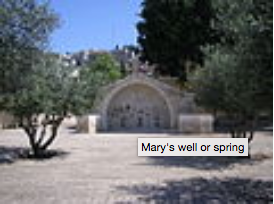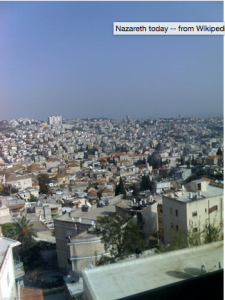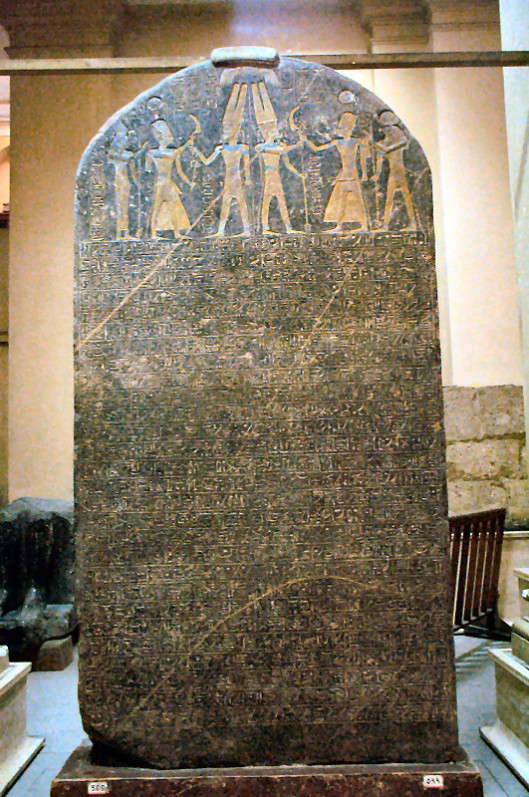Note 09/09/2009 — Plan to re-write much of this post in a future update — have finally caught up with some of my library and now see some misleading generalizations and possible (minor) errors in this post.
George Athas, author of “the first comprehensive, systematic, and complete treatment of the Tel Dan Inscription as a whole” (Aufrecht, 2007), responded in 2006 to a confused critic who mistook him for a “minimalist”. Athas’s response, Setting the Record Straight: What Are We Making of the Tel Dan Inscription?, is unfortunately without cost only to those who belong to institutions subscribing to the Journal of Semitic Studies.
First some background:
The Tel Dan Inscription refers to a stele discovered in northern Palestine and originally erected, around 800 b.c.e., by a Syrian king with a message boasting of victories over kings. Its special significance is that it contains the word widely transliterated as “byt dwd”, and translated as “House of David”, meaning a royal dynasty of David, and by extension, the Kingdom of Judah. This is generally accepted as archaeological evidence for the existence of the biblical David. In this way the inscription has been interpreted through the biblical references to the House, or royal dynasty, of David.
A few other scholars who attempt to interpret archaeological finds independently of biblical references interpret the inscription as making a reference to a place. They compare, for example, place-names like Beth-lehem or Beth-el (literally “house of bread” and “house of god”), and suggest Beth-dwd/david is likewise a place-name, literally meaning “house of blessing”. Some of these scholars also present the case that even if the words did refer to the dynasty of David, that that would not prove the historical existence of David himself. Many ancient (and modern) royal dynasties claim mythical ancestors.
George Athas is not a “minimalist”. He writes of the united kingdom (of Israel-Judah under David and Solomon) that the Tel Dan Inscription “suggests that it was a reality.” So Athas takes a position about the biblical literature, in particular its Primary History, that considers it at some level a historical record about the past, and he also interprets the inscription through the bible narrative. He differs from the mainstream, however, in seeing it as a reference to “the city of David” (Jerusalem). (A so-called “minimalist” would accept that the biblical literature contains some details from past records but that whether its contents are historical or theological or other or from what era is another question entirely. Any particular nature of a literature’s relationship with artefacts needs to be demonstrated, not assumed.)
George Athas “setting the record straight”:
Athas argues strongly that the famous word on the stele, “Bayt-Dawid”, “is not a dynastic label for Judah, but rather a toponym referring to Jerusalem as a city-state. It is the Aramaic parallel to . . . ‘City of David’).”
His reasons for this conclusion are both simple and complex.
The simplest reason is that the inscription reads, “king of b-tdwd”. Athas points out that we would not expect the expression, “King of the House of David”. A king is not a king “of” their dynastic name. “[A] king does not rule a dynasty — he rules a kingdom, a specific area of land.”
The comparison with the Assyrian inscription of “The House of Omri” (applying to the dynasty of the northern kingdom of Israel) is beside the point. The Assryian inscription is a direct reference to the dynasty ruling Israel. The Tel Dan inscription is different because the expression is preceded by the word(s) “king of”.
The complex reason I will leave to reviewer Walter E. Aufrecht to sum up:
The suggestion that bytdwd is a toponym rests on the following: the noun ‘îr (‘city’ as in the Hebrew ‘îr dawîd, i.e., Jerusalem) is unattested in Old Aramaic. It is likely that the writer used the Old Aramaic word bayt to render the Hebrew ‘îr of ‘îr dawîd. Furthermore, the interchange of ‘îr and bêt “is certainly not unheard of ”: Athas cites Josh. 19:41, where the town of Beth Shemesh is referred to as ‘îr sms (p. 280). So the inscription is talking about a place which the Aramaic author knew as the “city of David.” I think this is a brilliant notion, though I confess it took me two close readings of Athas’s sometimes dense exposition to convince me. (p.67)
There is much more to Athas’s article since he is addressing the major points of a critical review of his book. I’ve zeroed in on the bits of most general interest here. Aufrecht concludes:
As far as I am concerned, Athas has solved the crucial and most contentious issue in the debate over the Tel Dan Inscription, the meaning of the letter sequence bytdwd. And he has done it, by and large, on sound epistemological grounds.
Athas does see this toponym as “evidence”, but not “proof”, that David was an historical figure.
Ninth century Jerusalem as a city-state?
This interpretation means that the city Bytdwd was originally understood by the Syrian author to be a city-state.
(Interestingly, this interpretation (based in a significant part on the context in which it appears) supports Thomas L. Thompson’s argument — see my previous post/s — that Jerusalem was principally a city-state as opposed to being the central administration centre of a larger political unit or state (Judah).)
But “city-state” sounds very grandiose for a site that archaeologists have established was really quite small at this time.
Athas addresses this notion. He explains, citing Gabriel Barkay:
We tend to define cities as large sites, well fortified, where the building density is greater than in sites termed villages. In biblical times, however, any place built by royal initiative or housing a representative of the central authority, even a small site or isolated fort, was called a city (‘ir).
My own thoughts:
My own thoughts are that it is worth remembering that the name of the capital cities of Italy, Greece and Assyria do not mean that Romulus, Athena and Asshur had any role in their founding. The land of Canaan does not, by its name, prove that Canaan was a literal son of Noah and progenitor of the peoples who settled there. The name of Europe is certainly not evidence for the historical reality of the Phoenician woman of that name who was abducted by Zeus disguised as a fine white bull. The city name Tarentum does not legitimize Taras as an historical figure. The city of Eryx does not establish the existence of Eryx the host of Hercules. Besides, before the emergence of biblical literature and its themes it may well be that “dwd” or “david” was a circumlocution for a deity (“the Blessed One”).
It is worth keeping in mind that in other circumstances, especially where there is less pressing need to find evidence to support biblical accounts, scholars are quick to explain that legends so often emerge to explain places, names and customs after the fact.
In the cases of Saul, David and Solomon, I am persuaded (partly through some of Thomas L. Thompson’s discussions) that these characters are depicted as three theological “types”: Saul the epitome of all that is outstanding in human righteousness and appearances, David the flawed and rejected one whose heart is in the right place and who is for this reason is especially loved by God, and Solomon who lets “having it all” lead to his demise. These themes appear regularly throughout the Primary History (Genesis – 2 Kings) and through them all God’s highest, non-human righteousness and wisdom rules. They are all presented to us as theological exemplars. Without corroborating evidence it is rash to see any of these three as historical figures.
Like this:
Like Loading...
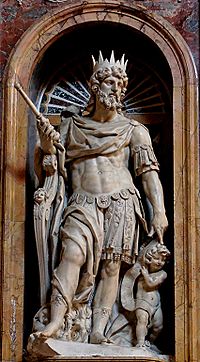 Here I look at the argument that the inscription (bytdwd) apparently referring to David (dwd) or the “house of David” in the Tel Dan Inscription is best explained as a reference to an epithet (meaning “beloved”) for the god Yahweh.
Here I look at the argument that the inscription (bytdwd) apparently referring to David (dwd) or the “house of David” in the Tel Dan Inscription is best explained as a reference to an epithet (meaning “beloved”) for the god Yahweh.
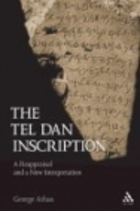
 René Salm discusses Nazareth and Nazarenes, James and Paul, Christianity and Buddhism, and Ventures Old and New
René Salm discusses Nazareth and Nazarenes, James and Paul, Christianity and Buddhism, and Ventures Old and New
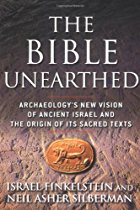 Two archaeologists, one Israeli (Israel Finkelstein) and one American (Neil Asher Silberman), have bizarrely managed to repackage a Taliban-like ancient biblical legal code into a modern enlightened expression of human rights, human liberation and social equality.
Two archaeologists, one Israeli (Israel Finkelstein) and one American (Neil Asher Silberman), have bizarrely managed to repackage a Taliban-like ancient biblical legal code into a modern enlightened expression of human rights, human liberation and social equality.